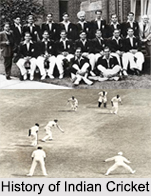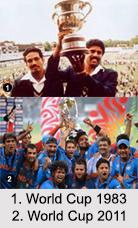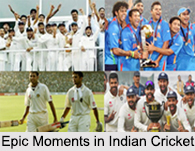 History of Indian Cricket reveals the fact that though the game was introduced by the British Government in India, its popularity kept on increasing with passing time. Cricket is now celebrated as a major sport in India. Cricket is considered to be a religion in India. There are no sure theories about the origin of Cricket in India but as British ruled on India for over 200 years, the game can be called as their legacy. The game took around four centuries to reach India. British brought this game to India in the 17th century. The first ever cricket match in India was played in 1721 AD. Initially accepted by the Parsi community, this game of foreigners began to appear in organized form with the establishment of the "Oriental Cricket Club" in 1848.
History of Indian Cricket reveals the fact that though the game was introduced by the British Government in India, its popularity kept on increasing with passing time. Cricket is now celebrated as a major sport in India. Cricket is considered to be a religion in India. There are no sure theories about the origin of Cricket in India but as British ruled on India for over 200 years, the game can be called as their legacy. The game took around four centuries to reach India. British brought this game to India in the 17th century. The first ever cricket match in India was played in 1721 AD. Initially accepted by the Parsi community, this game of foreigners began to appear in organized form with the establishment of the "Oriental Cricket Club" in 1848.
India started playing Cricket way back in 1721 unofficially but was granted the official test status in 1932. They played their first test cricket match from 25th June to 28th June in the year 1932 against England at Lords` in London. India was lead by C.K. Nayudu at that time. India was considered a weak team in the Cricketing Circuit for long time but Indian team changed from 1950s and is a major force to reckon with today.
 First Indian Cricket Club
First Indian Cricket Club
The first Indian Cricket club, named the Parsee Oriental Cricket Club, was founded in that year and they played their first match in Bombay (Mumbai). From this point, the journey of Indian cricket began. This cricket club of Mumbai marked the beginning of interest of Indian people in cricket. The first official cricket match was played between Parsis and Europeans in 1877 AD. Till late 19th century people of this country did not open their hearts to the game.
Indian Cricket in 20th Century
After its initiation, Cricket started gaining popularity among the Indian people within a short period of time. The middle and last half of the 19th century was an important period in the history of Indian Cricket, as the game spread its reach in almost all the parts of India during that period.
The First Test Match was played in 1932. Though India did not have a national cricket team during the early 1900s, a few Indian great cricketers of that era did represent the England cricket team. Maharaja Ranjit Singh and Duleep Singhji were the prominent ones among them.
Indian Cricket during 1950s
After Independence, a big push came in the history of Indian Cricket, when India got its first ever Test series win against the neighbouring Asian counterpart and archrivals Pakistan, in 1952. The series saw brilliant and extraordinary performances from some of the greatest Indian Cricket players like Polly Umrigar, Vijay Manjrekar and S.M. Gupte.
Indian Cricket during 1960s
The Indian Cricket during 1960s saw the Indian team becoming a formidable side on native soil. It was also the decade, when the Indian team started playing well in overseas. India`s great performances on home soil were evident when India defeated New Zealand and held the teams like Pakistan, England and Australia to a draw, during that period. The 1960s also saw the rising of some of the greatly talented Indian Cricket players like Mansoor Ali Khan Pataudi, Dilip Sardesai, Hanumant Singh, Chandu Borde and E.A.S. Prasanna.
Indian Cricket during 1970s
The era of India`s spin quartet comprising Bishen Singh Bedi, Erapalli Prasanna, B.S. Chandrasekhar and Srinivas Venkataraghavan during 1970s, is considered as the golden era in the history of Indian Cricket. Apart from the spinners, 1970s also saw the rising of two of India"s greatest ever batsmen - Sunil Gavaskar and Gundappa Vishwanath. All of these great Indian Cricket players made their presence felt in the international circuit and contributed immensely in the success of Indian team. India successfully won consecutive Test series in West Indies and England in 1971 and the team was led by Ajit Wadekar, in both the series.
 Indian Cricket during 1980s
Indian Cricket during 1980s
During the 1980s, India developed a more attack minded batting line-up with stroke makers such as Mohammed Azharuddin, Dilip Vengsarkar and all-rounder Ravi Shastri prominent during this time. India won the Cricket World Cup in 1983, defeating West Indies in the final. In 1984, India won the Asia Cup and in 1985, won the World Championship of Cricket in Australia. Apart from this, India remained a very weak team outside the Indian subcontinent. The 1980s saw Sunil Gavaskar and Kapil Dev at the pinnacle of their careers. Sunil Gavaskar made a Test record 34 centuries as he became the first man to reach the 10,000 run mark. Kapil Dev later became the highest wicket taker in Test cricket with 434 wickets.
Indian Cricket during 1990s
The addition of Sachin Tendulkar and Anil Kumble to the national side in 1989 and 1990 improved the Indian Cricket team. The following year, Javagal Srinath, India`s fastest bowler since Amar Singh, made his debut. Rahul Dravid and Saurav Ganguly made their debut in the same Test at Lord`s. Sachin Tendulkar resigned; vowing never to captain the team again, with Saurav Ganguly appointed the new captain. The team was further damaged in 2000 when former captain Mohammad Azharuddin and fellow batsman Ajay Jadeja were implicated in a match-fixing scandal and given life bans
Indian Cricket during 2000s
Since 2000, the Indian team underwent major improvements with the appointment of John Wright as India`s first ever foreign coach. India maintained their unbeaten home record against Australia in Test series after defeating them in 2001. The series was famous for the Kolkata Test match, in which India became only the third team in the history of Test cricket to win a Test match after following on.
Victory in 2001 against the Australians marked the beginning of a dream run for India under their captain Saurav Ganguly, winning Test matches in Zimbabwe, Sri Lanka, West Indies and England. The England series is also known for India`s highest ODI run-chase of 325 runs at Lord`s which came in the Natwest ODI Series final against England. In the same year, India was joint winners of the ICC Champions Trophy with Sri Lanka, and then went to the 2003 Cricket World Cup in South Africa where they reached the final only to be beaten by Australia.
Greg Chappell took over from John Wright as the new coach of the Indian cricket team following the series, and his methods proved to be controversial during the beginning of his tenure. The tension resulted in fallout between Chappell and Ganguly, resulting in Rahul Dravid being made captain. This triggered a revival in the team`s fortunes, following the emergence of players like Mahendra Singh Dhoni, Suresh Raina, Irfan Pathan and Yuvraj Singh.
Introduction of Twenty20 International Tournaments in India
In December 2006, India played and won its first ever Twenty20 International in South Africa, becoming the most recent Test team to play Twenty20 cricket. After winning the Test series against England in August 2007, Rahul Dravid stepped down as the captain of the team following which Mahendra Singh Dhoni was made the captain of the Twenty20 and ODI team. In September 2007, it won the first ever Twenty20 World Cup held in South Africa, beating Pakistan by 5 runs in a thrilling final.
India in World Cup 2011
India under the coaching of Gary Kristen won the Cricket World Cup in 2011, after a long time since 1983, under the captaincy of Mahendra Singh Dhoni and Yuvraj Singh became the man of the tournament. The Indian team beat Sri Lanka by 6 wickets, in the final match which was played in Mumbai. Apparently, India became the first country to win the tournament in native soil.
India played its 500th Test match against New Zealand at Kanpur from 22nd September 2016. India won this match by 197 runs. This test was played under the captaincy of Virat Kohli.






























